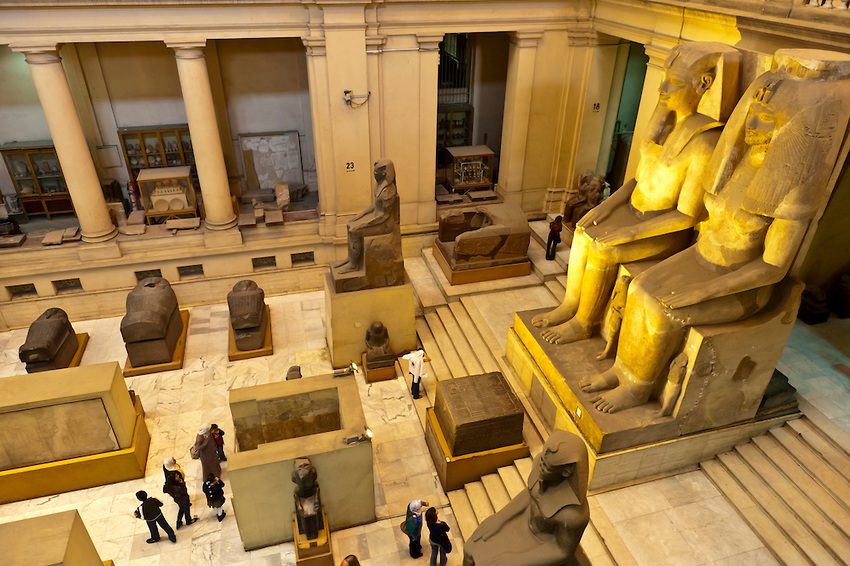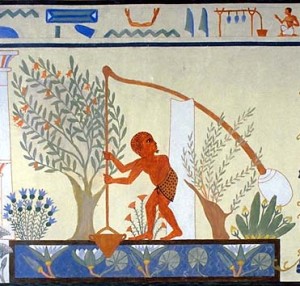By Amira Elhamy
The Pharaohs who built one of the world’s wonders, the Pyramids, had their society organised as a pyramid as well. The segmentation within the ancient Egyptian society and the meticulous organisation of each activity were actually the main reasons behind a strong economic system.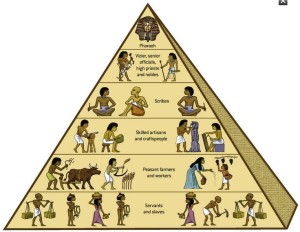
The society was divided into 8 important segments starting from the base of the pyramid, which starts with slaves and servants, followed by farmers, artisans, merchants, scribes, soldiers, government officials (nobles, priests), and the Pharaoh at the top of the pyramid. The high degree of organisation and communication between those eight segments is the key of the strength which characterized the economic system within the Egyptian society. Duties were assigned based on specialization, which made every man/woman master what he or she is accomplishing.
Labour was divided according to gender:
Ancient Egyptians were able to successfully divide labour according to gender; while men grew flax, their women spun it into thread and wove the linen. Fishing was also an important aspect; fish was caught by men and had to be cleaned and dried by women, to be of much use in the hot climate of Egypt, unless they were consumed immediately. The Egyptian society did actually recognise women as equal to men, but as having an essential complementary, expressed especially in the action of producing children. This respect is expressed clearly in the Ancient Egyptian theology and morality, but it is difficult to determine the extent of its application in the daily life of Egyptians. Most women belonging to the peasantry, worked alongside their husbands doing agricultural work. Women were known to manage farms or businesses in the absence of their husbands or sons. Within the high social classes women were able to achieve important social positions. There were several examples indicating how women reached high official position. The royal blood was a key for a woman to become a ruling pharaoh; it is worthy to note that one of the prosperous ruling period which witnessed a strong economic system was the ruling period of Queen Hatshepsut, who organised trade trips to the land of Punt in Somalia. 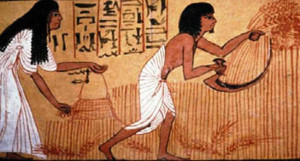
Manufacturing:
Ancient Egyptians were able to make the best use out of the raw materials. Gold and silver had a significant economic value within the Egyptian market. A large part of the manufactured goods came from the families which produced the raw materials. The metals used for tools were copper, bronze and, iron. Artisans were the segment which made the best use of metals. Their work was not vastly displayed at the Egyptian markets; some of them targeted clientele from the royal household and nobility and bourgeoisie. As for cabinet makers, they crafted furniture for the rich class. Poorer people continued to use stone and wooden tools. Gems remained in the possession of a wealthy minority and the stone quarried for temples and tombs served the same class of people and profited only the craftsmen involved in the building. In the towns, there were small factories, often financed by rich noblemen: bakeries, breweries, carpentry workshops and the like with a few dozen employees. Weaving, for instance, became a largely male occupation with the introduction of upright looms during the New Kingdom.
The strength of the economic aspect:
On the economical aspect, Egyptologist Ahmed Seddik, stated that there is so much to learn from the ancient Egyptian economic system. A timeless sense of justice marked their economy since it was the temple that controlled the economic activities in ancient Egypt, hence, economic injustice is tantamount to deprivation from the mercy of the gods. While economic prosperity translated into more reserve in the temples. It is a two-way street. Justice in the form of economic equilibrium was the grammar behind the glamour of ancient Egypt. 
“The high degree of organisation, tasks’ distribution, harnessing of natural resources, sustainability, and renewable energy were the key success elements of the economic system during the pharaohs’ ruling,” confirmed Seddik.
For the sake of economic prosperity the ancient Egyptians almost literally left no stone unturned. They knew exactly how to exploit their resources, they harnessed the wind power to move their barges from lower Egypt to upper Egypt then they followed the flow of the Nile that moved them from upper Egypt to lower Egypt. They actually invented recycling before the word recycling was invented. From a single plant they invented paper to communicate and boats to navigate. Aside from the economic benefits that plant was part of the plan to keep the land united. Therefore having a kind of a united market for the whole country. It is easy to see that the ancient Egyptian economy was a model of self-sufficiency since their currency was sustainably green and made of grain. The ancient Egyptian banks consisted of multiple granaries located along the river banks, with a great deal of accessibility to give and take. That is to say they were producing their own food in the form of their currency, explained Seddik.
Energy resources:
The ancient Egyptian had many energy resources. The main resource was the human power. They were clever in knowing how to make the best use of human labour. Temples, pyramids, and ornaments are the best examples that indicate how human labour within the ancient Egyptian society was the strongest aspect.
They were able to make the best use of natural energy resources which Egypt enjoyed such as, wind energy, fire and solar energy. Wind energy was exploited to navigate ships. The Egyptians were fortunate in that the Nile flowed from south to north. The winds were northerly and sufficed to blow the ships upriver. They were let to drift downriver with furled sails; but often a destination could only be reached through rowing which required large crews. As for fire they used it for, smelting and casting metal, glassmaking, and burning pottery. For the working of metals high temperatures had to be achieved and this was done quite possibly with charcoal. Ancient Egyptians succeeded in using solar energy; they used the heat of the sun in the production of mud bricks, which were the perfect building material in Egypt.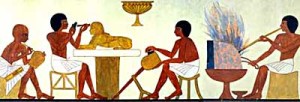
It is worthy to note that the strong economic system within such a high degree of organisation is what made the pharaohs succeed to keep a civilization which left its significant traces until the 21st century.

